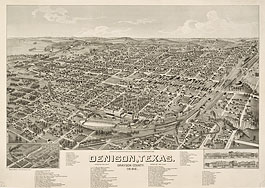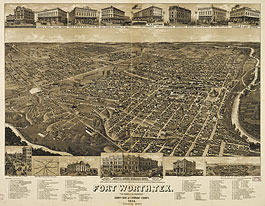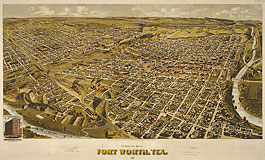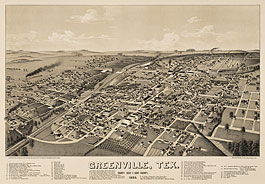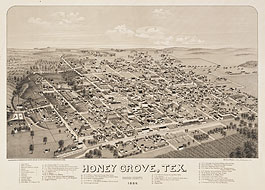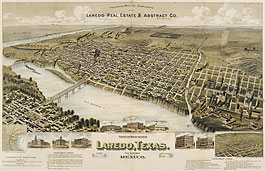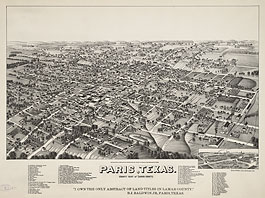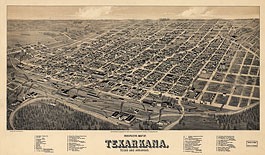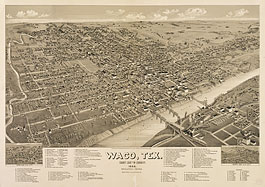Denison in 1886
Henry Wellge was an experienced bird’s-eye-view artist by the time he began his Texas tour in 1885. With more than fifty prints to his credit, he produced an India-ink drawing of Denison, more or less the northern entrance into Texas, that one correspondent claimed “shows at a glance the character of the country, the location and development of our city.” Denison was a city literally built by the railroad… [More]
Fort Worth in 1886
The arrival of the railroad ushered in an era of astonishing growth for Fort Worth as migrants from the devastated South continued to swell the population and small, community factories and mills yielded to larger businesses. Newly dubbed “Queen City of the Prairies,” Fort Worth supplied a regional market via the growing transportation network. More smokestacks are evident in Henry Wellge’s 1886 view, which the editor of the Fort… [More]
Fort Worth in 1891
The fact that Henry Wellge was back in Fort Worth in 1891 to revise his 1886 view demonstrates the concern the city fathers had in promoting the city, as they tried to recover from the difficult economic conditions. Again depicting the city from the northeast, Wellge showed the same basic area as in the 1886 print, suggesting that he might have used the earlier print as a pattern for… [More]
Greenville in 1886
Wellge continued his tour of the North Texas cotton-farming country with a visit to Greenville late in 1885. Prior to the arrival of the railroads, Greenville had been what one historian called an “inland island,” thirty miles from a railroad in any direction and a modest producer of traditional agricultural crops. But an increase in the number of slaves before the Civil War and the arrival of the railroads… [More]
Honey Grove in 1886
Traveling eastward, probably on the Texas and Pacific Railroad, Wellge continued his tour of North Texas with a visit to Honey Grove, a little more than forty miles from Denison. The city got its name from a nearby grove of trees, where the early settlers found an apiary. The arrival of the T&P in 1873 had turned the village of about 300 persons into a small, regional center with… [More]
Laredo in 1892
The railroads brought prosperity and new settlers to Laredo when they arrived in 1881, and the city grew from an 1880 population of 3,521 to 11,319 in 1890. But instead of focusing on the railroads, as many other bird’s-eye-view artists had done, Henry Wellge emphasized the results of the railroads, which had turned Laredo into a growing city and the gateway to Mexico. The Texas Mexican Railway linked Laredo… [More]
Paris in 1885
Henry Wellge completed his large drawing of Paris, Texas—which one correspondent pronounced “very accurate in detail”—before the end of the year 1885. Working with George E. Norris, who was his partner and sales agent, they printed the image with the Beck & Pauli lithographic firm in Milwaukee late that year.
According to John H. Patterson, a reporter for Frank Leslie’s Illustrated Newspaper, Paris was the center of a… [More]Texarkana in 1888
Texarkana is located in a densely wooded area on a plateau between the Red and Sulphur rivers at the site of an old Indian trail that was for hundreds of years the main route between the Indian villages of the Mississippi River area and those to the west. The city was founded in December 1873 on the site where, hardly a month later, the Cairo and Fulton Railroad (from… [More]
Waco in 1886
Considerable growth had taken place in Waco from the time Herman Brosius produced his view in 1873 to 1886, when Henry Wellge provided a careful update in his view. Two more railroads—the Houston and Texas Central and the Missouri, Kansas and Texas—had built lines through the city, including two new railroad bridges over the Brazos River. Waco was in the process of becoming a transportation and commercial hub for… [More]











